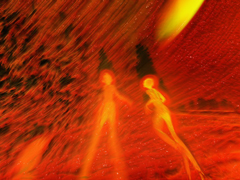| RIKEN Center for Developmental Biology (CDB) 2-2-3 Minatojima minamimachi, Chuo-ku, Kobe 650-0047, Japan |
September 30, 2008 – Over 800 people filled the Kyoto Kaikan Hall on August 22, 2008 to take in “An Evening of Science and Music- a glimpse at life”, sponsored by the Japan Society for Science and Technology (JST) and co-organized by RIKEN. This event was part of an initiative by JST to combine art and science with the goal of conveying the wonders of science to a wider audience. This collaborative event featured a talk by Masatoshi Takeichi (Director of the RIKEN Center for Developmental Biology) followed by a performance by Masakatsu Takagi (video artist and musician). One of the highlights of the evening was the world premiere of Takagi’s newest piece “NIHITI”, the concept of which originated from his visit to the CDB earlier this year to learn more about cells and biological phenomena.
The evening was emceed by Masaki Nakamura, Associate Professor of Modern Thought and Culture at Osaka University, and began with a talk by Takeichi entitled, “The wonders of development and the mysteries of life.” The talk featured many images and movies of developmental phenomena, and included details on cell behaviors and the role of genetics. A dialogue between Takeichi and Takagi followed the lecture, where they exchanged their views on common ground between art and science. Asked about what inspired him in his work, Takeichi said, “Regardless of whether you are looking at flowers or insects, all life phenomena are beautiful. I carry out research with the hope that by attempting to reveal the essence of life, we will stumble upon an ultimately beautiful phenomenon. Art and science are alike in that they both seek ultimate beauty.” He also commented, “There are times when cells evoke a sense of music through their dynamic and rhythmic movements.”
The concert portion of the evening featured eight pieces, including Ceremony, Girls, NIHITI, and Primo, performed by Takagi (piano) accompanied by Haruka Taguchi, Miho Ota and Jadranka (vocals). The music was complemented by beautiful visuals produced by Takagi. Reflecting on the production of NIHITI, a Polynesian word thought to be the origins of the similarly pronounced word in Japanese for “rainbow”, Takagi explained, “Learning that scientists use diverse methods to look at cells and the molecules contained within those cells, I felt that research itself was an attempt to look at objects that are not visible to the naked eye. I enjoy looking at rainbows and have always been mystified at how rainbows appear out of nowhere.” At the end of the evening, Takeichi, Takagi and Nakamura returned to the stage to reflect on their collaboration. “I have always sensed with my heart and mind, but through learning about developmental research, I feel that I have discovered a new sensation within myself, that is, ‘sensing through cells. ’ I perceive this as the sensation of each cell within the body stirring when encountering something awe-inspiring. If human beings have evolved since the dawn of time, then perhaps the memories of that journey are ingrained within the cells,” commented Takagi. Takeichi remarked, “I realized that science was no match for art, in terms of leaving an impression on people. We scientists hope to carry out research that will leave a deeper impression on everyone.” Video footage of this event is scheduled to air on Sky Perfect TV’s Science Channel (http://sc-smn.jst.go.jp/) at 8:30 PM on January 10, 2009. |
||||||||||
 |
| Copyright (C) CENTER FOR DEVELOPMENTAL BIOLOGY All rights reserved. |

